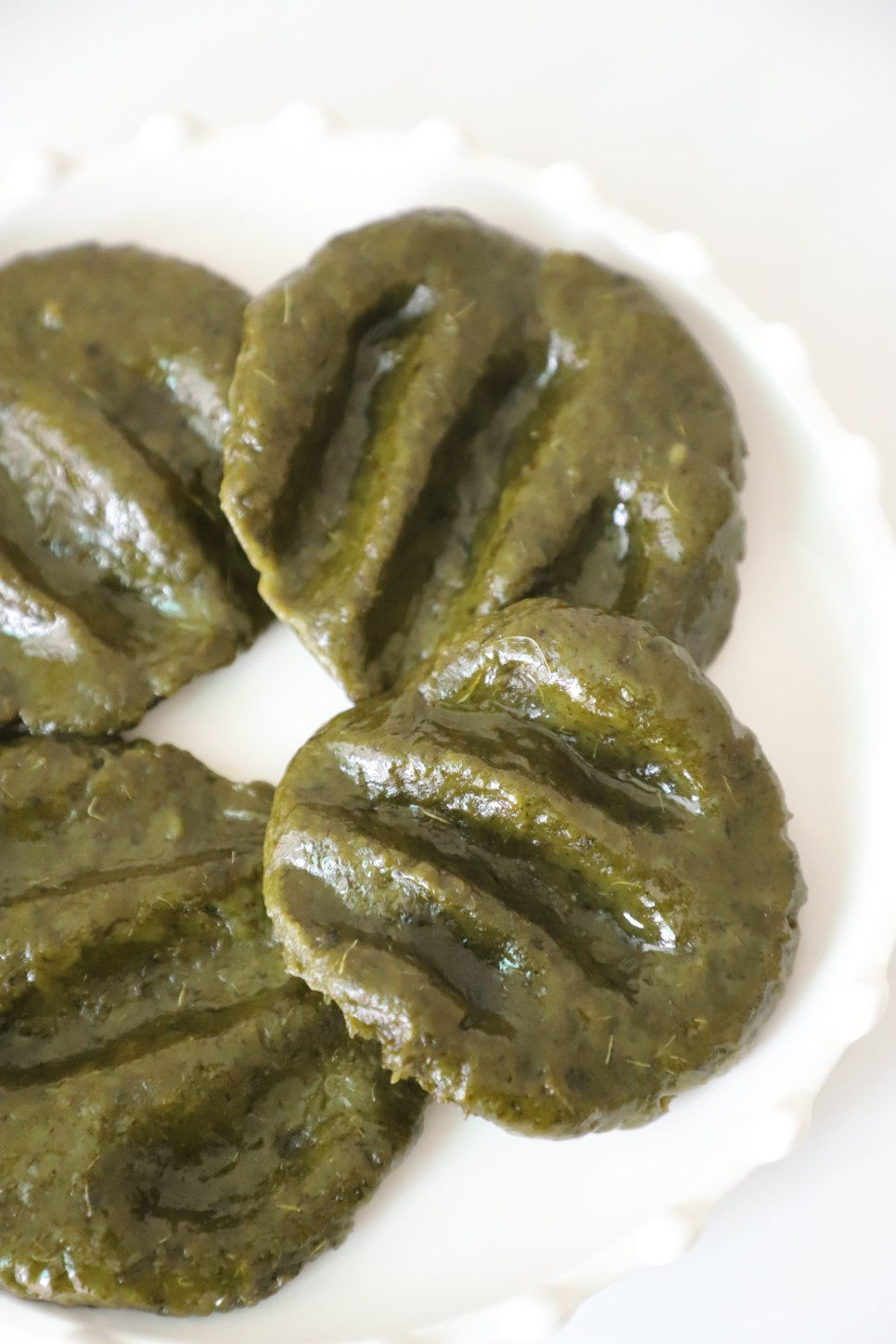Spring Aroma & Chewy Perfection: How to Make Mugwort Rice Cakes (Ssuk-gaetteok)
Master the Art of Ssuk-gaetteok! Learn to shape them like palms, create the perfect chewy texture, and store leftover dough with this detailed guide.

While I’m not a huge fan of all types of rice cakes, I absolutely adore those that are subtly sweet, savory, and delightfully chewy, like Jeolpyeon or Ssuk-gaetteok. Come spring, I love gathering mugwort and making this delightful treat. It’s a perfect way to capture the essence of spring in every bite.
Core Ingredients- 300g non-glutinous rice flour (sifted)
- 100g boiled mugwort (water squeezed out thoroughly and finely chopped)
- 1/2 tsp salt (adjust according to the amount of rice flour)
- Warm water, as needed (approx. 50-70ml, adjust for dough consistency)
Cooking Instructions
Step 1
For those who want to make the Ssuk-gaetteok dough from scratch, here’s a detailed explanation. First, wash the non-glutinous rice thoroughly and soak it in water until well-plumped. Drain it as much as possible. Clean the mugwort, boil it until very soft, rinse in cold water, and squeeze out all excess water. Take these prepared rice and mugwort to a local rice cake shop or mill and ask them to grind them together into flour. They can also add the appropriate amount of salt based on the flour’s weight. While I prefer my Ssuk-gaetteok unsweetened, if you like a touch of sweetness, you can request them to add sugar.

Step 2
Place the freshly ground rice flour in a large bowl. Gradually add warm water while kneading the dough. The amount of water may vary depending on the rice flour and the moisture content of the mugwort, so it’s best to add it little by little and adjust the consistency. Be careful not to make the dough too wet. The ideal dough consistency is one that is not sticky to your hands but can be molded into a chewy ball. The more you knead, the chewier the rice cake will be, so knead it as much as you can until your arms ache!

Step 3
You can portion the well-kneaded dough into pieces about half the size of your fist and shape them into small, flattened rounds. However, for a slightly easier and more uniform shape, you can first roll the dough into a long log.

Step 4
Then, use a knife to cut the log into evenly sized pieces. This makes shaping the individual cakes much more convenient.

Step 5
Take one of the cut dough pieces and place it in your palm, forming it into a round shape.

Step 6
Gently press down on the dough with your palm to flatten it into a disc about 1cm thick. Making it too thin might cause the cakes to dry out quickly, so maintaining a moderate thickness is ideal.

Step 7
Finally, use three fingers to press firmly into the center of the dough, creating indentations. This signature touch gives the Ssuk-gaetteok its characteristic look.

Step 8
With just a simple press, your adorable palm-shaped Ssuk-gaetteok are ready! See how easy that was?

Step 9
Arrange the shaped Ssuk-gaetteok on your steamer, leaving some space between them to prevent sticking. Lightly dampening the steamer basket with water beforehand or lining it with a damp cloth can also help prevent sticking.

Step 10
Fill the bottom of the steamer with plenty of water and bring it to a rolling boil over high heat. It’s important to wait until the steamer is producing a generous amount of steam.

Step 11
Once the steam is strong, place the steamer basket onto the pot, cover it with the lid, and steam over high heat for about 20 minutes. The steaming time may vary slightly depending on the amount of mugwort and the thickness of the dough.

Step 12
While the Ssuk-gaetteok are steaming, let me show you how to store any leftover dough. While you can steam and then freeze the Ssuk-gaetteok, it’s generally tastier to shape the raw dough, freeze it, and then steam it later. To prevent the dough from sticking, lay out a sheet of plastic wrap on a tray or plate, place the shaped dough pieces on it, cover with another layer of plastic wrap, and then add another layer of dough. This method also works for storing dough before steaming.

Step 13
Once the dough is well-wrapped and organized this way, place it in the freezer for at least half a day, or until it’s completely frozen solid. The shapes will remain intact and firm.

Step 14
When the dough is solidly frozen, remove it from the freezer, place it in a zip-top bag, seal it tightly, and store it. Whenever you crave Ssuk-gaetteok, just take out as many pieces as you need, and steam them directly without thawing for a treat that’s as good as freshly made!

Step 15
As the 20 minutes of steaming came to an end, I opened the pot lid. Seeing the fragrant, steamy Ssuk-gaetteok immediately brought a sigh of ‘Wow!’ The aroma of spring was truly captivating.

Step 16
Be careful, as freshly steamed Ssuk-gaetteok are very hot! Gently remove them from the steamer and place them on a wide plate or tray, not directly on the pot, to let them cool down slightly. Once they’ve cooled enough to handle, put on disposable gloves and lightly brush both sides of the warm cakes with sesame oil. This prevents them from drying out and adds a delicious nutty flavor.

Step 17
While delicious when warm, Ssuk-gaetteok are even chewier and more flavorful when completely cooled. Allow them to cool sufficiently to enjoy their delightful chewy texture. Leftover Ssuk-gaetteok can be stored in an airtight container and will keep for 2-3 days.




